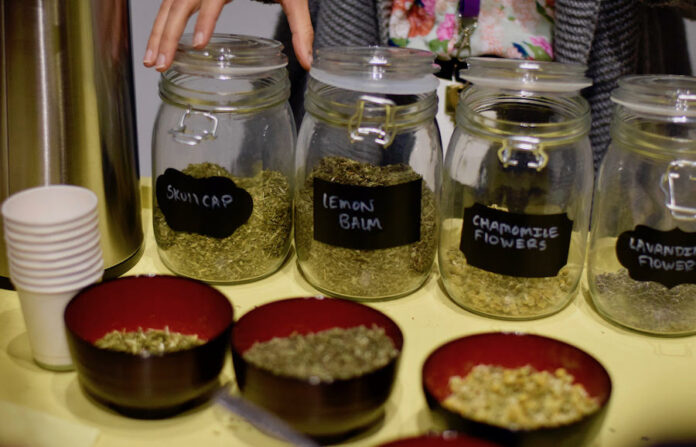On Feb. 1, students and community members gathered for “Xicanx Futurity” exhibition
As part of the Manetti Shrem Museum of Art’s “Xicanx Futurity” exhibit, a rolling cart known as Botanica del Barrio can be found between 12 p.m. and 2 p.m. on the first Friday of February, March, April and May, nestled in a corner beside a wall of the artist’s work. On these days, the museum offers an interactive “Make Your Own Tea Blend” event with information about the effects of different types of herbal tea blends. On Feb. 1, two serpentine lines trailed from each side of the cart — one line of people waiting to try the tea and another line waiting to make their own blend.
The exhibit offered four different herbs, each with different calming and relaxing benefits which were presented on a flier and by museum employees. According to the flier, chamomile is “a mild sedative and good gastric anti-inflammatory” that soothes the nerves, and skullcap is a relaxing nervine that is helpful for “nerve tremors, stress, menstrual tension or cramps and nervous exhaustion.” Lemon balm is used for digestive problems, pain, anxiety and sleep problems, and lavender is used for relaxation and to promote restful sleep. In the blend served at the Feb. 1 event, they used an equal amount of chamomile, skullcap and lemon balm and half as much lavender, as lavender is considered to be very strong.
Museum staff were not expecting such a large turnout, so for the first couple of hours, they ended up setting out a bowl with the same blend that they were serving — instead of having each attendee make their own blend — to expedite the process. Toward the end of the event, more attendees made their own blends and were assisted by employees who explained the benefits of each herb and the artist’s intentions in creating the cart.
The Director of museum education Jessica Wimbley described the process of bringing the Botanica del Barrio inside the museum. Initially, to even consider having the cart inside the museum, the artist, curators, exhibition team and visitor services had a conversation to ensure that the materials on the cart wouldn’t damage the artwork and to gain a full understanding of the artists and curators intention.
“Felicia ‘Fe’ Montes is a Xicana/Indigena artist who works in Los Angeles, California,” Wimbley said. “She considers herself to be an ‘artivist,’ which is a combination of being both an artist and an activist […] there’s very much this social interactive component in which the goal of the work is to be able to share information with the community about different herbal remedies and medicines, especially those rooted in Mexican and indigenous medicine and tradition.”
For the “Xicanx Futurity” exhibition, the museum has been working with the Chicana/Chicano Studies department closely. Two of the guest curators are from this department: Carlos Jackson, an associate professor and chair, as well as Susy Zepeda an assistant professor. There has also been student engagement, with students from the department utilizing the Botanica del Barrio as well as being involved in other interactive parts of the exhibition.
“Well, the museum is very proud to have this exhibition here,” Wimbley said. “This partnership with the Chicana/Chicano Studies department has been a wonderful partnership in pushing the research [of professors at Davis] and celebrating a history of artists who have been working who may not have gotten as much exposure in traditional museum contexts. And advocacy for artists within the community is something that we feel is important to support and highlight.”
Student attendees included second-year undeclared major Albert Jai, who is part of the Pal Program, a program that “pairs up undergraduate students for intercultural conversation experiences,” promoted the event. Jai generally drinks Chinese and Japanese green teas but doesn’t particularly have any preferences.
“I’ll drink coffee for the purpose of staying up,” Jai said. “I’ll drink tea for the purpose of enjoyment.”
Third-year biological sciences major Kacey Phonesavath has attended past events at the museum and enjoys getting the chance to take a look at new exhibits. She discovered the event on Facebook and decided to go, not only to check out “Xicanx Futurity” but also to drink tea, something she does daily.
“I usually like darker blends that are really bitter and strong,” Phonesavath said. “I had a really open mind and I thought, ‘it’d be something different — maybe a flavor that I hadn’t tasted’ […] I don’t think I’ve heard of skullcap.”
Jai also said that part of the reason he likes tea is because he is Asian, and he discussed the parallels he observed between Asian cultures and Latin American cultures at the event.
“In Latin America, as well as Asian countries, a lot of herbal medicine is used, in contrast to Western medicine,” Jai said. “And all I can say is, I think it works sometimes, but I don’t know how it works.”
Wimbley was happy with the turnout for all of the events through the “Xicanx Futurity” exhibition thus far and thinks that it will continue.
“I think it’s important to build a safe space in which students are seeing themselves reflected in the exhibition, in the artists, in the curators,” Wimbley said. “And I think we have a wonderful opportunity to provide that for students here in Davis […] I think the idea of us really being able to encourage, engage, celebrate and give a space for voice for the department, for the curators, for the artists and for the students is something that’s important to exist as a 21st century museum today.”
Written by: Anjini Venugopal — features@theaggie.org




